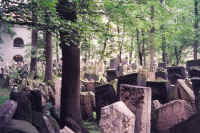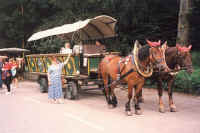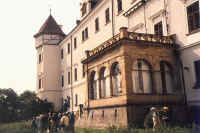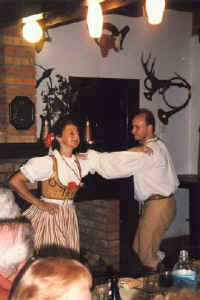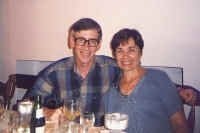|
Prague
Sunday, 26 July:
With a local guide, our group caught the subway at 9:00 a.m. for the tour of
the Jewish Quarter. We walked north from Old Town into Josefov to the
Staronova (Old-New) Synagogue, "the oldest synagogue north of the
Alps." It is now a memorial for the nearly 80,000 Prague Jews killed in
the Holocaust. Their names are inscribed on the walls. Just behind the
synagogue is the old Jewish cemetery, with 12,000 stones, some dating back
to 1439. The stones are crowded together with almost no open space. Because
there was no other Jewish cemetery available, over the centuries fresh soil
was spread over the cemetery to allow for more burials. The old tombstones
were raised to the new level and stood next to the new stones that were
added. After this happened a few times, the cemetery was almost completely
covered with stones.
Leaving the cemetery, we passed the building that housed the Burial Brotherhood, which was responsible for the cemetery. Just down the narrow street is the Pinkas Synagogue, erected after World War II. Our guide then led us down the street to the Kapara Cafe where we had coffee and apple strudel. The tour disbanded at that point. We walked down Paris Street to Old Town Square in time to attend 11 o'clock Mass at the Tyn Church. Afterwards we returned to Josefov for another look at the Jewish Quarter. In one of the stalls near the Burial Brotherhood, I bought a calendar featuring 12 pictures by Alfons Mucha, a leading art nouveau artist at the turn-of-the century. That disposed of the last of our Czech korunas. We took the subway back to our hotel.
The bus left at 2:30 for the optional tour to Konopiste Castle, several miles outside of Prague. A horse
drawn wagon took us from the parking lot to the entrance. The castle was originally built in the 13th century as a
fortress, but over the years was converted into a French-style baroque chateau. In 1887 it became the official
residence of Austrian Archduke Franz Ferdinand, whose assassination in 1914 touched off World War I. He
was an avid hunter and the walls of the castle are lined with many of his 300,000 trophies.
After touring the castle's interior, we walked half a mile around a private lake to an old hunting lodge
that was now a restaurant. The main course was pheasant roasted on a spit. It was quite good. Between
courses and after the meal, there was folk dancing in which many of our group joined. One of the two owners
of the restaurant openly pawed our local guide and every other woman he danced with. He eyed Jane, too, but
we were sitting back in a corner out of reach. Jane commented that she didn't want him to get near her. As
we all left the restaurant, though, he immediately rushed over to Jane and draped his arm over her shoulder.
I took his wrist and firmly threw his arm back. He gave an embarrassed laugh and stayed away from us.
Katie put on a tape of "golden oldies" as the bus took us back to Prague, and we all sang along. We got to our hotel at 9:30 p.m. and began packing for our morning departure.
Copyright © 2000-2023 DarrellPeck.com All rights
reserved. | |||||||

